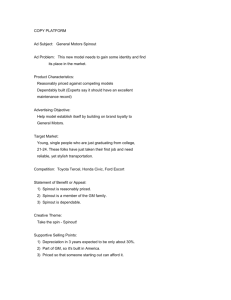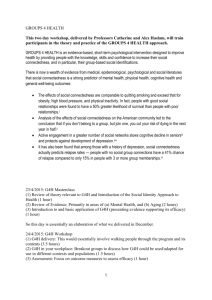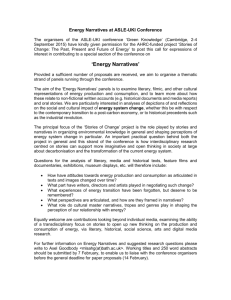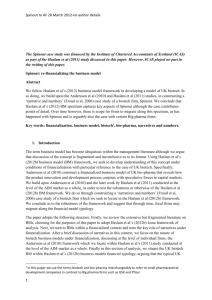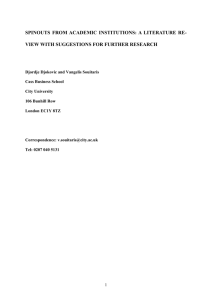view comments
advertisement
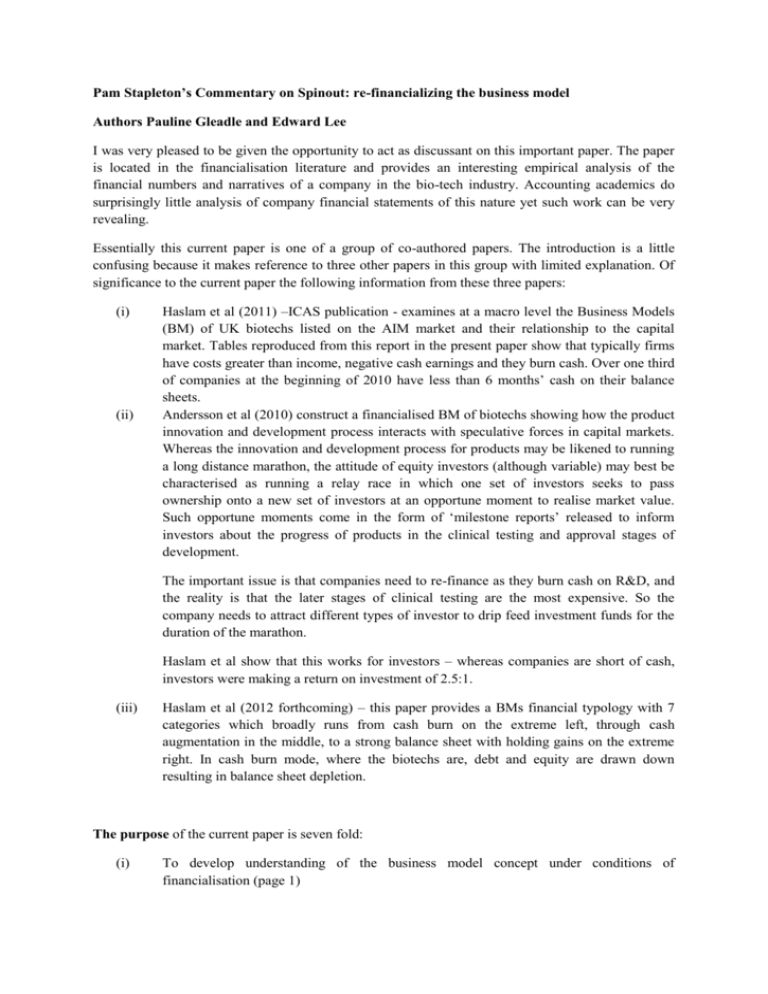
Pam Stapleton’s Commentary on Spinout: re-financializing the business model Authors Pauline Gleadle and Edward Lee I was very pleased to be given the opportunity to act as discussant on this important paper. The paper is located in the financialisation literature and provides an interesting empirical analysis of the financial numbers and narratives of a company in the bio-tech industry. Accounting academics do surprisingly little analysis of company financial statements of this nature yet such work can be very revealing. Essentially this current paper is one of a group of co-authored papers. The introduction is a little confusing because it makes reference to three other papers in this group with limited explanation. Of significance to the current paper the following information from these three papers: (i) (ii) Haslam et al (2011) –ICAS publication - examines at a macro level the Business Models (BM) of UK biotechs listed on the AIM market and their relationship to the capital market. Tables reproduced from this report in the present paper show that typically firms have costs greater than income, negative cash earnings and they burn cash. Over one third of companies at the beginning of 2010 have less than 6 months’ cash on their balance sheets. Andersson et al (2010) construct a financialised BM of biotechs showing how the product innovation and development process interacts with speculative forces in capital markets. Whereas the innovation and development process for products may be likened to running a long distance marathon, the attitude of equity investors (although variable) may best be characterised as running a relay race in which one set of investors seeks to pass ownership onto a new set of investors at an opportune moment to realise market value. Such opportune moments come in the form of ‘milestone reports’ released to inform investors about the progress of products in the clinical testing and approval stages of development. The important issue is that companies need to re-finance as they burn cash on R&D, and the reality is that the later stages of clinical testing are the most expensive. So the company needs to attract different types of investor to drip feed investment funds for the duration of the marathon. Haslam et al show that this works for investors – whereas companies are short of cash, investors were making a return on investment of 2.5:1. (iii) Haslam et al (2012 forthcoming) – this paper provides a BMs financial typology with 7 categories which broadly runs from cash burn on the extreme left, through cash augmentation in the middle, to a strong balance sheet with holding gains on the extreme right. In cash burn mode, where the biotechs are, debt and equity are drawn down resulting in balance sheet depletion. The purpose of the current paper is seven fold: (i) To develop understanding of the business model concept under conditions of financialisation (page 1) (ii) (iii) (iv) (v) (vi) (vii) To test the robustness (or not) of the forthcoming financial typology framework by Haslam et al (2012b) (page 1) To understand the robustness of the UK biotech business model (BM) (page 3) To generate alternative perspectives of how organisations function in a financialised context (page 2) To explore the way in which a firm evolves adapts and responds to the information demands of stakeholders within the bio-tech BM (page 8) To use case studies to generate robust conclusions about the relation between the stock market and innovative capabilities (page 9) To be a part of a construction at an international level of a more complete view of the relationship between the biotech firms to big industry players and the capital markets (page 15) Literature Review The concept of the ‘business model’ has become widely used in the management literature, and growing reference to the term is evidenced by an increase in search hits from 140k in 2011 to 175k in 2012. But despite this widespread use the concept lacks a clear theoretical base and the literature thereon may be described as fragmented. The present authors (following Haslem et al 2012b) use BM to connote a new unit of analysis with three characteristics: (i) (ii) (iii) A wide boundary of organisational analysis The nature of BMs is defined by their activity and system level characteristics BMs help us to understand how organisations create value But the central purpose of a BM is to generate a financial surplus out of which on-going capitalisation can be augmented. Magretta (2002) observes that a viable BM must have both coherent narratives and sound financial numbers. This clearly forms the link to the financialisation literature. While this financialisation literature has a number of strands the paper is interested in the growing influence of financial markets where institutions act to change firms’ behaviour (as opposed to acting as mere intermediaries). Company strategy is financialised because there is pressure on managers to deliver ever higher returns. While the outcomes of the strategy may be variable the role of narratives is key. The research method is case study based and it follows Froud et al’s (2006) approach of narratives and numbers to construct the case from financial information and interviews. The choice of case follows that of Haslam et al (2011) - the UK biotech industry – specifically those companies that are listed on the AIM between 1998 and 2010. In this paper the focus is on one such company Spinout. The financial position of Spinout Pattern of revenues seen to be volatile, company is loss making and at end of 2010 only 5 months of cash burn, and share price is more volatile than the average for the AIM – so Spinout is in a vulnerable position, despite the fact that it has been going since the 1990s. It is especially vulnerable given that large industry players are taking a more cautious approach to investment – meaning that Spinout needs to invest more in the expensive later stage clinical development before they can attract the big player. As was seen in the 1990s in the US new economy firms, companies are recovering costs from capital markets rather than product markets. In some very rich empirical data, a distinction is drawn between the needs of the company (and its preferences) and market emphasis – meaning that the company must make compromises to survive. What it really needs of course is sustainable profitability, but projects such as investing in production capability are expected to take too long to produce results meaning that the market will not support them. Nevertheless the paper argues Spinout is not at the extreme left end of the financial typology – rather it fits into the second category from the left – cash burn + income – because it has some income from licenses. So, cash depletion is less than its competitors so its BM is more viable than its peers. Discussion The paper argues that the Andersson et al (2010) and Haslam et al (2011) papers capture many aspects of the findings from Spinout, but do not cover: (i) (ii) Some points of detail – eg. motivations of different kinds of investors (those who enter and exit during the relay race), and the relationship with a big industry player The balance of interests between the big players attitude to joint projects versus other work that would generate milestone reports and hence satisfy other investors The authors argue the Haslam et al (2012) financial typology framework is useful. The UK biotech BM is vulnerable because of the complexity of the stakeholder network By using a narratives and numbers approach, the current paper argues it is able to flesh out the detail of the framework. My Comments The project of which this paper is a part is an extremely interesting one, and I believe this paper can make a valuable contribution. At present the rather long list of purposes spread over a number of pages means that the paper lacks some focus. One clear statement of purpose that would direct /focus the rest of the paper would be helpful. There is necessarily a lot of reference to the three linked papers, but this at present blurs the distinctive contribution of the current paper. Four issues to raise: (i) (ii) It is, for example, not made clear /explicit here why it is useful to test the robustness of the framework forthcoming by Haslam et al (2012). Over many years there has been a lot of literature debating companies’ perspective that capital markets take a short termist view versus the perspective of capital markets actors that this is not necessarily the case. This literature is not really acknowledged. I think the case can be made that the biotech industry is a very specific set of circumstances which is (iii) (iv) why this paper can make a contribution even though some of the issues (such as small firms’ inability to attract capital for projects of a longish duration) are not new. This discussion section notes that the findings support those of Froud et al (2006) who identified the role of narratives in their study of Big company GlaxoSmithKline, and found that share prices are bid up on the basis of social narrative about possible transformations – advances in R&D and progress against milestone. This however begs the question – why was it important / useful to examine one small company in the same industry? What does this add to our understanding? It is not made clear why it matters that Spinout is not at the extreme left of the typology but rather at the second point in. I would be interested to hear the authors comment about the extent to which it is now possible to draw robust conclusions about the relation between the stock market and innovative capabilities. Was Lazonick’s (2007) call for case studies to reveal this relationship the right way to go? The CFO makes reference to a ‘living death’ when discussing the cash flow position and on page 14 the paper suggests that the BM might migrate along the financial typology to the right – but that certain policy interventions might be needed. Given the significance of the industry and the current financial crisis what kinds of intervention would be helpful and reasonable? One issue that the paper does not address is the huge incentive inherent in the financing structure to paint the best possible picture of company progress in milestone reports. Are there specific regulatory or other controls over this process – or is it simply market forces – lie once and we never believe you again? Minor points Paper needs a better introduction it is rather confusing for readers who are not familiar with the Haslam et al, papers and the Andersson et al framework. For example, the reader is invited to consider the far left hand side (cash burn) of a spectrum they have not yet been introduced to. Note 1 – it is not helpful to readers to use the same term interchangeably. Better to use one or the other exclusively or to use them individually for specific definitions if appropriate.
